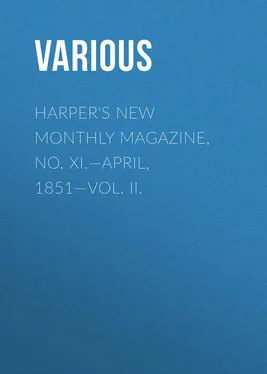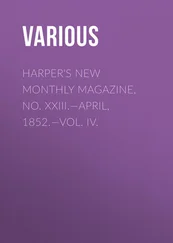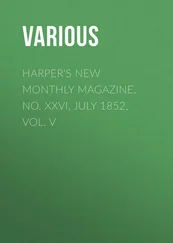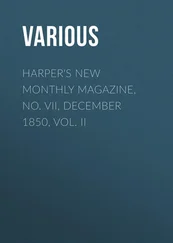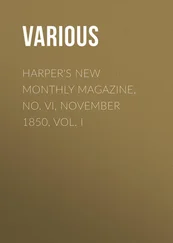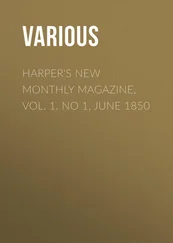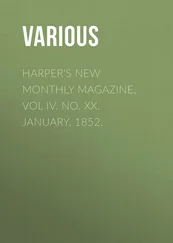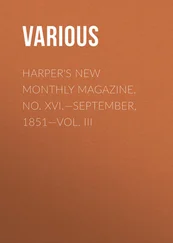Various - Harper's New Monthly Magazine, No. XI.—April, 1851—Vol. II.
Здесь есть возможность читать онлайн «Various - Harper's New Monthly Magazine, No. XI.—April, 1851—Vol. II.» — ознакомительный отрывок электронной книги совершенно бесплатно, а после прочтения отрывка купить полную версию. В некоторых случаях можно слушать аудио, скачать через торрент в формате fb2 и присутствует краткое содержание. Издательство: Иностранный паблик, Жанр: periodic, foreign_edu, на английском языке. Описание произведения, (предисловие) а так же отзывы посетителей доступны на портале библиотеки ЛибКат.
- Название:Harper's New Monthly Magazine, No. XI.—April, 1851—Vol. II.
- Автор:
- Издательство:Иностранный паблик
- Жанр:
- Год:неизвестен
- ISBN:нет данных
- Рейтинг книги:5 / 5. Голосов: 1
-
Избранное:Добавить в избранное
- Отзывы:
-
Ваша оценка:
- 100
- 1
- 2
- 3
- 4
- 5
Harper's New Monthly Magazine, No. XI.—April, 1851—Vol. II.: краткое содержание, описание и аннотация
Предлагаем к чтению аннотацию, описание, краткое содержание или предисловие (зависит от того, что написал сам автор книги «Harper's New Monthly Magazine, No. XI.—April, 1851—Vol. II.»). Если вы не нашли необходимую информацию о книге — напишите в комментариях, мы постараемся отыскать её.
Harper's New Monthly Magazine, No. XI.—April, 1851—Vol. II. — читать онлайн ознакомительный отрывок
Ниже представлен текст книги, разбитый по страницам. Система сохранения места последней прочитанной страницы, позволяет с удобством читать онлайн бесплатно книгу «Harper's New Monthly Magazine, No. XI.—April, 1851—Vol. II.», без необходимости каждый раз заново искать на чём Вы остановились. Поставьте закладку, и сможете в любой момент перейти на страницу, на которой закончили чтение.
Интервал:
Закладка:
In respect to the decoration of the interior, a keen controversy has been waged. The fact of iron being the material of construction renders it necessary that it should be painted to preserve it from the action of the atmosphere. On the one hand, it is said that the fact that the structure is metallic should be indicated by the decoration, otherwise the whole will have no more appearance of stability than an arbor of wicker-work. Those who take this view recommend that the interior should be bronzed. On the other hand, those to whom the decoration is intrusted affirm that the object of using color is to increase the effect of light and shade. If the whole were of one uniform dead color the effect of the innumerable parts of which the building is composed, all falling in similar lines, one before the other, would be precisely that of a plane surface; the extended lines of pillars presenting the aspect of a continuous wall. In order to bring out the distinctive features of the building various colors must be used; and experiments show that a combination of the primary colors, red, blue, and yellow, is most pleasant to the eye. The best means for using these is to place blue, which retreats, upon the concave surfaces, yellow, which advances, upon the convex ones, reserving red for plane surfaces. But as when these colors come in contact each becomes tinged with the complementary color of the other – the blue with green, the red with orange – a line of white is interposed between them. Applying these principles, the shafts of the columns are to be yellow, the concave portions of their capitals blue, the under side of the girders red, and their vertical surfaces white.
Among all the wonders of the Crystal Palace nothing is more wonderful than its cheapness, and the rapidity of its construction. Possession of the site was obtained on the 30th of July; in a period of only 145 working-days the building was to all intents and purposes completed. As to cheapness it costs less per cubic foot than an ordinary barn. If used only for the Exhibition, and at its close returned to the contractors, the cost will be nine-sixteenths of a penny a foot; or, if permanently purchased, it will be one penny and one-twelfth. Thus: The solid contents are 33,000,000 cubic feet; the price if returned is £79,800, if retained £150,000. This simple fact, that a building of glass and iron, covering eighteen acres, affording room for nine miles of tables, should have been completed in less than five months from the day when the contract was entered into, at a cost less than that of the humblest hovel, opens a new era in the science of building.
As to the final destination of the Crystal Palace, it is the wish of the designer that it should be converted into a permanent winter-garden with drives and promenades. Leaving ample space for plants, there would be two miles of walks in the galleries, and the same amount for walks upon the ground floor; in summer the removal of the upright glass would give the whole the appearance of a continuous walk or garden.
Sir John Franklin, in command of the "Erebus" and "Terror," having on board one hundred and thirty-eight souls, set sail from England on the 19th of May, 1845, in search of a northwest passage. On the 26th of July, sixty-eight days afterward, they were seen by a passing whaler moored to an iceberg near the centre of Baffin's Bay; since which time no intelligence of their fate has been received. No special anxiety was entertained respecting them until the beginning of 1848, for the commander had intimated that the voyage would probably continue for three years, and that they might be the first to announce their own return. But as month after month passed away without bringing any tidings, an anxious and painful sympathy sprung up in the public mind, and the British Government determined that searches for the missing vessels should be made in three different quarters by three separate expeditions fitted out for that purpose.
One quarter, however, that region known as Boothia, where there was a probability of success, was beyond the scope of these expeditions, and Lady Franklin determined to organize an expedition to explore that region. For this purpose she appropriated all the means under her control; and a subscription was opened to supply the deficiency. The "Prince Albert," a ketch of less than ninety tons burden, measuring in length about seventy-two feet, and seventeen in breadth, was purchased for the expedition. She was taken to Aberdeen to be fitted up; a double planking was put upon her, by way of pea-jacket to fit her for her arctic voyage, and a crew of fourteen canny Scotchmen, secured by the promise of double pay. Captain Forsyth, of the Royal Navy, proffered his gratuitous services as commander. Attached to the expedition, having special charge of the stores and scientific instruments, with the express understanding that he should head one of the exploring parties to be sent out from Regent's Inlet, was Mr. W. Parker Snow, from whose Journal we propose to draw up some account of the pleasures of sailing through the ice.
Mr. Snow seems to have been precisely the man for such an undertaking. He left America at three days' notice to join any expedition which might be sent out by Lady Franklin. With an active, hopeful temperament, never so happy as in a gale of wind, if it was only blowing the right way, he rushed to the embrace of the Arctic Snows with as much alacrity as though they were kinsmen as well as namesakes. He had, moreover, a happy faculty of turning his hand to every thing, and no disposition to hide his talent in a napkin. A physician had been engaged for the vessel; but when, two days before sailing, the disciple of Esculapius saw the diminutive craft, he declined to proceed: – Mr. Snow volunteered to perform his duties; he had read a little medicine at odd hours; and by the aid of Rees's Guide, and Smee's Broadsheet, his practice was uniformly successful – either in spite of, or on account of, his informal professional training. The sailors, as might be expected from their Scotch blood, were desirous of having religious worship on board: – Mr. Snow offered his services as chaplain, reading and expounding the Scriptures, and offering up prayer.
On the 6th of June, 1850, the Prince Albert set sail from Aberdeen; a fortnight brought them within two hundred miles of the shores of Greenland. Then came, for a week, a succession of heavy gales, which drove them back upon their course; so that in six days their progress was not more than a dozen miles. The 1st of July, however, found them off Cape Farewell. Some idea of the multifarious occupations of the many-officed Mr. Snow, at a time when his proper duties had not commenced, may be gathered from his description of
LIFE ON SHIPBOARD
"At half-past six I used to turn out; and, warm or cold, wet or dry, take an immediate ablution in the pure and natural element. For half an hour I would then walk on deck, fair or foul; and, a little before eight, examine the men's forecastle; see to their condition, and whether any of them were sick; and if so, give them medicine. At eight bells, I would then take the chronometrical time for Captain Forsyth, while he observed the altitude of the sun, to get our longitude. Latterly I used, by his desire, to take a set of sights also myself, taking the time from a common watch, and comparing it afterward with the chronometer. The chronometers were then wound up by me, and the thermometer, barometer, &c., registered. At eight o'clock the two mates went to breakfast; the captain and I getting ours soon after them. During the forenoon I had to attend to the stores, provisions, &c.; write my accounts, journals, and other papers; and at noon worked up the ship's reckoning, the observations, and wrote the ship's log, examining our present position and future course. The mates had their dinner at noon: the captain and I at three P.M.; after which, a stroll for an hour or so on deck was taken by both of us. Tea came round at six, and at eight P.M. I used to try the temperature of the air on deck, and of the sea. After that, we would read together in the stern cabin. At ten, we would take our hot grog; and, generally about eleven, when free from rough weather or the neighborhood of ice, turn in for the night. Very little candle was required below at night, as there was seldom more than an hour or two's darkness during any part of our voyage, until we were returning. It was not long after this date, moreover, that we had continued daylight through the whole twenty-four hours."
Читать дальшеИнтервал:
Закладка:
Похожие книги на «Harper's New Monthly Magazine, No. XI.—April, 1851—Vol. II.»
Представляем Вашему вниманию похожие книги на «Harper's New Monthly Magazine, No. XI.—April, 1851—Vol. II.» списком для выбора. Мы отобрали схожую по названию и смыслу литературу в надежде предоставить читателям больше вариантов отыскать новые, интересные, ещё непрочитанные произведения.
Обсуждение, отзывы о книге «Harper's New Monthly Magazine, No. XI.—April, 1851—Vol. II.» и просто собственные мнения читателей. Оставьте ваши комментарии, напишите, что Вы думаете о произведении, его смысле или главных героях. Укажите что конкретно понравилось, а что нет, и почему Вы так считаете.
